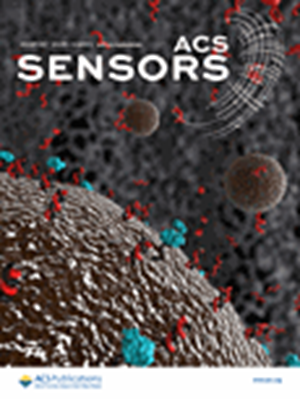用于超灵敏和选择性检测人体尿液中碘离子的无标记单分子电传感器
IF 9.1
1区 化学
Q1 CHEMISTRY, ANALYTICAL
引用次数: 0
摘要
本文首次提出了一种无标记单分子电传感器,用于超灵敏和选择性地检测人体尿液中的碘离子。通过扫描隧道显微镜断裂结(STM-BJ)对不同卤素离子溶液中单分子电导的测量清楚地表明,碘离子强烈影响分子结的稳定性和位移距离(Δz)分布。理论计算证明,I 离子的特定吸附改变了表面性质,削弱了分子吸附。此外,在 5 × 10-6 至 5 × 10-10 M 的范围内,平均电导峰面积与 I- 离子浓度的对数具有很好的线性关系,相关系数为 0.99。在存在 SO42-、ClO4-、Br- 和 Cl- 等干扰离子以及抗坏血酸、尿酸、多巴胺和半胱氨酸等干扰分子的情况下,这种定量分析仍然有效。该单分子电传感器的人体尿液检测结果与临床上使用的 As3+-Ce4+ 催化分光光度法的检测结果进行了交叉比较,发现两者的平均差异为 0.9%,从而将传统方法的 2 小时检测时间缩短至约 15 分钟。这项工作证明了单分子电学技术在相关临床分析中的巨大实用潜力。本文章由计算机程序翻译,如有差异,请以英文原文为准。

Label-Free Single-Molecule Electrical Sensor for Ultrasensitive and Selective Detection of Iodide Ions in Human Urine
Herein, a label-free single-molecule electrical sensor was first proposed for the ultrasensitive and selective detection of iodide ions in human urine. Single-molecule conductance measurements in different halogen ion solutions via scanning tunneling microscopy break junction (STM-BJ) clearly revealed that I– ions strongly affect the stability and displacement distance (Δz) distribution of molecular junctions. Theoretical calculations prove that the specific adsorption of I– ions modifies the surface properties and weakens the molecular adsorption. Furthermore, the average conductance peak area versus the logarithm of the I– ion concentration has a very good linear relationship in the range of 5 × 10–6 to 5 × 10–10 M, with a correlation coefficient of 0.99. This quantitative analysis remains valid in the presence of interfering ions of SO42–, ClO4–, Br–, and Cl– as well as interfering molecules of ascorbic acid, uric acid, dopamine, and cysteine. A cross-comparison of the human urine detection results of this single-molecule electrical sensor with those of the clinical method of As3+-Ce4+ catalytic spectrophotometry revealed an average difference of 0.9%, which decreased the detection time of 2 h with the traditional method to approximately 15 min. This work proves the promising practical potential of the single-molecule electrical technique for relevant clinical analysis.
求助全文
通过发布文献求助,成功后即可免费获取论文全文。
去求助
来源期刊

ACS Sensors
Chemical Engineering-Bioengineering
CiteScore
14.50
自引率
3.40%
发文量
372
期刊介绍:
ACS Sensors is a peer-reviewed research journal that focuses on the dissemination of new and original knowledge in the field of sensor science, particularly those that selectively sense chemical or biological species or processes. The journal covers a broad range of topics, including but not limited to biosensors, chemical sensors, gas sensors, intracellular sensors, single molecule sensors, cell chips, and microfluidic devices. It aims to publish articles that address conceptual advances in sensing technology applicable to various types of analytes or application papers that report on the use of existing sensing concepts in new ways or for new analytes.
 求助内容:
求助内容: 应助结果提醒方式:
应助结果提醒方式:


